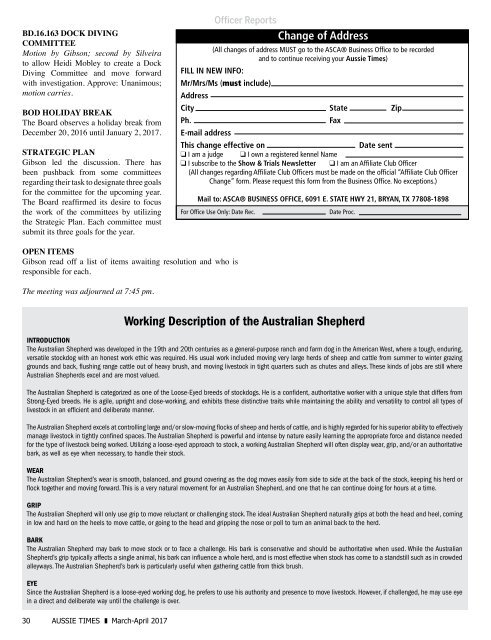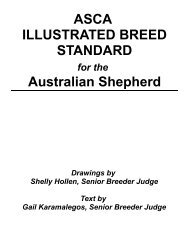Create successful ePaper yourself
Turn your PDF publications into a flip-book with our unique Google optimized e-Paper software.
BD.16.163 DOCK DIVING<br />
COMMITTEE<br />
Motion by Gibson; second by Silveira<br />
to allow Heidi Mobley to create a Dock<br />
Diving Committee and move forward<br />
with investigation. Approve: Unanimous;<br />
motion carries.<br />
BOD HOLIDAY BREAK<br />
The Board observes a holiday break from<br />
December 20, 2016 until January 2, <strong>2017</strong>.<br />
STRATEGIC PLAN<br />
Gibson led the discussion. There has<br />
been pushback from some committees<br />
regarding their task to designate three goals<br />
for the committee for the upcoming year.<br />
The Board reaffirmed its desire to focus<br />
the work of the committees by utilizing<br />
the Strategic Plan. Each committee must<br />
submit its three goals for the year.<br />
Officer Reports<br />
Change of Address<br />
(All changes of address MUST go to the ASCA® Business Office to be recorded<br />
and to continue receiving your Aussie Times)<br />
FILL IN NEW INFO:<br />
Mr/Mrs/Ms (must include)<br />
Address<br />
City State Zip<br />
Ph.<br />
Fax<br />
E-mail address<br />
This change effective on<br />
Date sent<br />
I am a judge I own a registered kennel Name<br />
I subscribe to the Show & Trials Newsletter I am an Affiliate Club Officer<br />
(All changes regarding Affiliate Club Officers must be made on the official “Affiliate Club Officer<br />
Change” form. Please request this form from the Business Office. No exceptions.)<br />
Mail to: ASCA® BUSINESS OFFICE, 6091 E. STATE HWY 21, BRYAN, TX 77808-1898<br />
For Office Use Only: Date Rec.<br />
Date Proc.<br />
OPEN ITEMS<br />
Gibson read off a list of items awaiting resolution and who is<br />
responsible for each.<br />
The meeting was adjourned at 7:45 pm.<br />
30 AUSSIE TIMES <strong>March</strong>-<strong>April</strong> <strong>2017</strong><br />
Working Description of the Australian Shepherd<br />
INTRODUCTION<br />
The Australian Shepherd was developed in the 19th and 20th centuries as a general-purpose ranch and farm dog in the American West, where a tough, enduring,<br />
versatile stockdog with an honest work ethic was required. His usual work included moving very large herds of sheep and cattle from summer to winter grazing<br />
grounds and back, flushing range cattle out of heavy brush, and moving livestock in tight quarters such as chutes and alleys. These kinds of jobs are still where<br />
Australian Shepherds excel and are most valued.<br />
The Australian Shepherd is categorized as one of the Loose-Eyed breeds of stockdogs. He is a confident, authoritative worker with a unique style that differs from<br />
Strong-Eyed breeds. He is agile, upright and close-working, and exhibits these distinctive traits while maintaining the ability and versatility to control all types of<br />
livestock in an efficient and deliberate manner.<br />
The Australian Shepherd excels at controlling large and/or slow-moving flocks of sheep and herds of cattle, and is highly regarded for his superior ability to effectively<br />
manage livestock in tightly confined spaces. The Australian Shepherd is powerful and intense by nature easily learning the appropriate force and distance needed<br />
for the type of livestock being worked. Utilizing a loose-eyed approach to stock, a working Australian Shepherd will often display wear, grip, and/or an authoritative<br />
bark, as well as eye when necessary, to handle their stock.<br />
WEAR<br />
The Australian Shepherd’s wear is smooth, balanced, and ground covering as the dog moves easily from side to side at the back of the stock, keeping his herd or<br />
flock together and moving forward. This is a very natural movement for an Australian Shepherd, and one that he can continue doing for hours at a time.<br />
GRIP<br />
The Australian Shepherd will only use grip to move reluctant or challenging stock. The ideal Australian Shepherd naturally grips at both the head and heel, coming<br />
in low and hard on the heels to move cattle, or going to the head and gripping the nose or poll to turn an animal back to the herd.<br />
BARK<br />
The Australian Shepherd may bark to move stock or to face a challenge. His bark is conservative and should be authoritative when used. While the Australian<br />
Shepherd’s grip typically affects a single animal, his bark can influence a whole herd, and is most effective when stock has come to a standstill such as in crowded<br />
alleyways. The Australian Shepherd’s bark is particularly useful when gathering cattle from thick brush.<br />
EYE<br />
Since the Australian Shepherd is a loose-eyed working dog, he prefers to use his authority and presence to move livestock. However, if challenged, he may use eye<br />
in a direct and deliberate way until the challenge is over.



